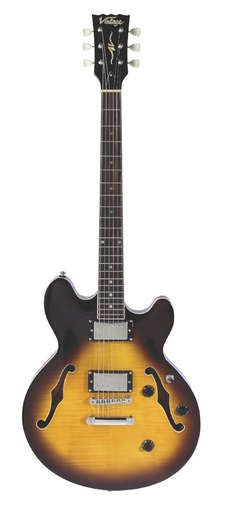Vintage has carved quite a market in the UK, and overseas, for its range of knock-offs, replicas, copies - call 'em what you will.
Leading guitar designer Trev Wilkinson has been working with the brand for the past couple of years and we've not only seen the quality and specification rise but Wilkinson has also enlivened the range with, for example, the Icon range of affordable aged replicas.
But with the launch of the Advance series, copy cloning is put on the back burner in favour of some more original designs like this guitar on test here.
Overview
This is such a neat 'inspired-by' design you can't help smiling. A slightly downsized, 'melted' ES-335, it's one of Mr Wilkinson's finest moments.
Aside from the headstock's shape, the overall outline works very well and the colouration of the dark vintage 'burst is wonderful.
Even that cheeky orange label that you can see through the bass-side f-hole is evocative of Gibson's finest period ES-335s. And at bang on 8lbs the weight is perfect.
Construction-wise it's interesting, too. We actually have a three-piece mahogany back that's chambered leaving a centre block, but that only runs from under the tailpiece up to the neck joint - not all the way through the guitar like on an ES-335.
And the flat back also helps to reduce the bulk. The solid maple top is carved inside and out and is topped with a figured maple veneer - again lightly flamed and perfect for the look.
Gibson ES-335s, of course, are built with pressed maple laminates - as are all the copies - but this construction, albeit with lower cost materials, is actually identical to the Hamer Monaco III reviewed on page 82.
Okay, internally it's a little rough and ready, but at a sixth of the price of the Hamer, few will care. The thin top-edge cream binding again looks old Gibson, as does the nicely graduated top carving.
The neck is very well shaped and the sunbursting to the back of the neck almost covers the headstock splice at the back.
Hardware and pickups, aside from the black pickup rings and black as opposed to gold knobs, are identical to the Vintage AV1.
Only the placement of the controls appears a little less than classic, although ergonomically the controls all fall easily under the hand.
Sounds
Lighter in weight, darker in tone but still with plenty of bite, this guitar impresses due to its versatility. You can go from a clean country twang (single-coil) to a dirty, feedback-laden soundscape with the kick of an amp channel, a change of the switch and a tweak of the roll control.
About the only thing missing is a Bigsby. It's a lot easier to handle than a ES-335 but still captures that bluesy snap and depth.
A smoother tone control taper would help but even if you simply replaced the three pots here you'll have a lot of classy sounding guitar for very little money.


